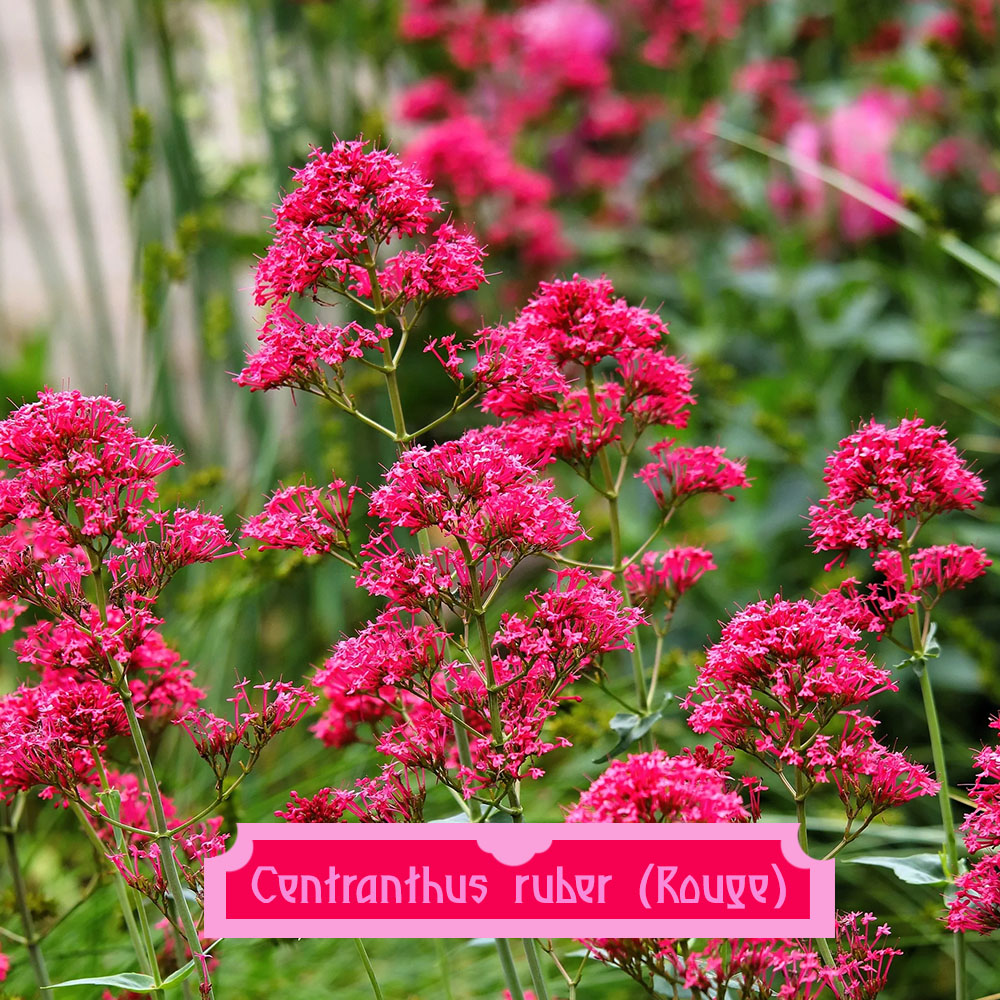No products in the cart.
Centranthus ruber
A wonderfully resilient perennial, producing red flowers
Rated 0 out of 5
0 customer reviews
4,90 €
Only 7 item(s) left in stock!
Tags: chaud, comestible, couleur, feuillage persistant, graphique, perennial, persistant, plant, potted plant, secheresse, soleil, vivace, vivace en pot, xeriscaping
SKU: pda457
Category: Bees and Butterflies, Bouquet, Frost Hardy, Rewild
Estimated Delivery :
2 days

Centranthus ruber
4,90 €
Only 7 item(s) left in stock!
Centranthus ruber is a wonderfully resilient perennial, producing fragrant, rose colored flowers all throughout the summer.
The flowers are large, fragrant and of a pink-red-magenta color.
Flowering takes place in early summer but will continue sporadically in cool summer areas, sometimes all the way into the fall. Deadheading will promote new growth!
The leaf form changes from the bottom to the top of the plant but is basically oval shaped. The lower leaves are petiolate (with stalk) while the upper leaves are sessile (without stalk).
The foliage is deciduous – it will dry out in autumn and return with panache the following spring.
It thrives in poor soils, tolerates drought, and is hardy in mild frost, making it suitable for rock gardens, slopes, borders, and walls. – really a perfect partner!
👨🌾GARDENING TIPS👨🌾:
-
- ⚠️The seeds have tufts, similar to dandelions, allow for wind dispersal, and as such can self-seed freely and become invasive if not properly controlled.
- To curtail the invasion, cut off the faded flowers before the plants to seed.
- 🌼This is what allows for it to peek through cracks and grow in old stone walls ( this is due to its ability to tolerate alkaline conditions and lime in mortar).
- ⚠️The seeds have tufts, similar to dandelions, allow for wind dispersal, and as such can self-seed freely and become invasive if not properly controlled.
-
- Continue learning about how to care for Centranthus/Valerian:
-
-
>> How to grow and care for red valerian (In English)
-
>> Valériane : des fleurs en continu et une culture super facile (In French)
-
-
- Continue learning about how to care for Centranthus/Valerian:
The Tales & The Botany:
The plant grows to between 30 and 90 centimeters in height.
🍃 The foliage is arranged oppositely along the stems and consists of lanceolate to ovate leaves, 2–6 cm long, covered with a fine indumentum of trichomes, which reduces water loss under high insolation. (this is responsible for its exceptional drought tolerance☀️)
Lower leaves are typically petiolate, while upper leaves are sessile, reflecting ontogenetic variation (relating to the origin and development of individual organism) along the stem.
The plant is semi-deciduous to deciduous, with senescence occurring in autumn in temperate climates and regeneration of foliage in spring.
🌸Floral morphology
Inflorescences are dense corymbs, with tubular, pentamerous flowers 15–20 mm in length, displaying shades from deep magenta to pale pink or occasionally white.
🧬Reproductive biology
Flowers are hermaphroditic and protandrous, promoting cross-pollination while maintaining self-compatibility.
🦋 Ecology & cultivation
Nectar production is high, making the species highly attractive to pollinators, including hymenopterans and lepidopterans. Flowering initiates in late spring and continues into midsummer, with sporadic anthesis in cooler climates extending into autumn. Deadheading promotes further flowering and biomass allocation to reproductive shoots.
C. ruber tolerates xeric conditions, nutrient-poor substrates, and high solar irradiance, and is resistant to moderate frost, corresponding roughly to USDA zones 5–9. Its adaptability and long-lasting floral display, combined with its subtle, silvery foliage, make Centranthus ruber a quintessential Mediterranean perennial.
Other Names:
Valerian
Red valerian
Spur valerian
Kiss-me-quick
Fox’s brush
Devil’s beard
Jupiter’s beard
Origin:
Mediterranean
| Weight | 0,5 kg |
|---|---|
| Flower Color | 🔴 Red |
| Flowering | July, August, September |
| Exposure | Full Sun |
| Frost Tolerance | -15°C to -20°C |
| Soil | Dry, Well-Draining |
| Size | 0.8m H x 0.4m W |
Reviews
0
Rated 0 out of 5
0 customer reviews
5
0
4
0
3
0
2
0
1
0
Only logged in customers who have purchased this product may leave a review.
You may also like…
Verbena bonariensis
Long stalks with light, floating purple specks that attract bees
Long stalks with light, floating purple specks that attract bees
Rated 0 out of 5
Leucanthemum x superbum Brightside
A bushy perennial that produces an explosion of large white flowers
A bushy perennial that produces an explosion of large white flowers
Rated 0 out of 5
Chrysanthemum Mei Kyo
A perennial with pink double pom-pom flowers
A perennial with pink double pom-pom flowers
Rated 0 out of 5
Related Products
Artemisia alba subsp camphorata
A highly fragrant, grey-green bush.
A highly fragrant, grey-green bush.
Rated 0 out of 5
Mentha x piperita ‘Chartreuse’
A spicy mint, known for its use in the production of liqueurs and herbal teas.
A spicy mint, known for its use in the production of liqueurs and herbal teas.
Rated 0 out of 5
Euphorbia myrsinites
Known for its draping form of silver-gray foliage and radiant blooms.
Known for its draping form of silver-gray foliage and radiant blooms.
Rated 0 out of 5
Satureja montana
A sweet smelling culinary herb from Europe
A sweet smelling culinary herb from Europe
Rated 0 out of 5
Erigeron kavinskianus
A daisy-like carpet of flowers
A daisy-like carpet of flowers
Rated 0 out of 5
Cerastium tomentosum var. columnae
A grey-green spreading ground cover from the mountains.
A grey-green spreading ground cover from the mountains.
Rated 0 out of 5
Jacobaea maritima
A wooly white perennial plant from the Mediterranean region.
A wooly white perennial plant from the Mediterranean region.
Rated 0 out of 5
Sedum album
A low, multi-color ground cover.
A low, multi-color ground cover.
Rated 0 out of 5
Billbergia nutans
A bromeliad featuring a three colored, striped flower
A bromeliad featuring a three colored, striped flower
Rated 0 out of 5
Hieracium maculatum Leopard
A native perennial with blue-green leaves and a tall yellow flower
A native perennial with blue-green leaves and a tall yellow flower
Rated 0 out of 5
Glechoma hederacea
A sweet smelling ground cover, producing little blue flowers all summer long.
A sweet smelling ground cover, producing little blue flowers all summer long.
Rated 0 out of 5
Achillea ptarmica Boule de Neige
White pompom flowers to attract bees to your garden all summer long.
White pompom flowers to attract bees to your garden all summer long.
Rated 0 out of 5
Echinops ritro
Tall, electric blue globe thistles
Tall, electric blue globe thistles
Rated 0 out of 5
Solidago ‘Golden Shower’
Beautiful showers of yellow flowers
Beautiful showers of yellow flowers
Rated 0 out of 5
Tanacetum densum subsp amani
A shrublet composed of soft, finely divided silvery gray-white leaves.
A shrublet composed of soft, finely divided silvery gray-white leaves.
Rated 0 out of 5
Tradescantia Blushing Bride
Gorgeous blushes of pink and white that appear in the coldest nights.
Gorgeous blushes of pink and white that appear in the coldest nights.
Rated 0 out of 5
Artemisia vulgaris Oriental Limelight
Striking green and yellow variegated foliage.
Striking green and yellow variegated foliage.
Rated 0 out of 5
Vinca minor
Looping elegance and ability to form a low flowering ground cover
Looping elegance and ability to form a low flowering ground cover
Rated 0 out of 5
recent view product
Jasminum nudiflorum
Winter jasmine – little yellow flowers for the dark winter days
Winter jasmine – little yellow flowers for the dark winter days
Rated 0 out of 5
Symphyotrichum ericoides f. prostratum ‘Snow Flurry’
Large airy ground cover of brilliant white flowers.
Large airy ground cover of brilliant white flowers.
Rated 0 out of 5
Brachyglottis greyi
Soft grey velvety velvety bush covered in bright yellow daisy flowers
Soft grey velvety velvety bush covered in bright yellow daisy flowers
Rated 0 out of 5
Aster novi-belgii ‘Henri Picot’
Large clouds of bright blue flowers.
Large clouds of bright blue flowers.
Rated 0 out of 5
Nepeta clarkei
Catnip from the mountains of Pakistan and India
Catnip from the mountains of Pakistan and India
Rated 0 out of 5
















































There are no reviews yet.